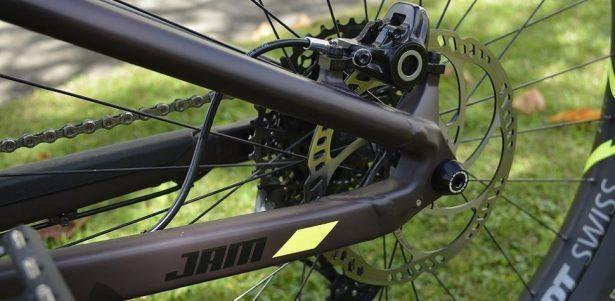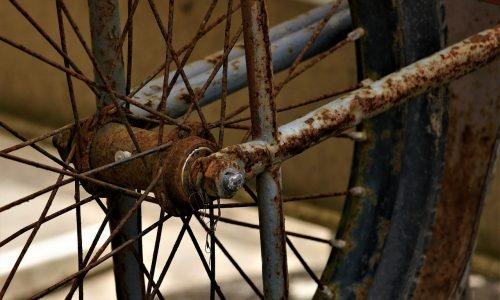Previously we have looked at looking after rim brakes, and now it is time to look at the brakes that are slowly taking over the world.
Disc brakes used to be solely the preserve of mountain bikes, but now you’ll find them on drop bar bikes, kids bikes, and even some high-end BMX bikes.
One of the things many people get worried about is doing maintenance on them. The thing is they are not difficult, like everything bike maintenance related, take your time and you’ll be fine.
Disc brakes regardless of the style of bike, come in 2 main varieties. You’ll get mechanical disc brakes or hydraulic disc brakes.

How to set up mechanical disc brakes
Mechanical disc brakes are a disc brake that uses a cable to pull the pistons together. Many people think they are old technology compared to hydraulic disc brakes, but if you take the time to set up your brakes correctly, you will probably not quite agree with them.
There are also advantages to mechanical disc brakes. If you live somewhere cold, you are not going to have a hydraulic fluid freeze on you at an inopportune moment. If you get to snag a cable it is easier to fix in the middle of nowhere than a hydraulic hose, and easier to pack spares.
The one thing you have to remember is that road bike levers, and mountain bike levers don’t have the same cable pull. You then need to make sure you get a specific road bike or mountain bike mechanical disc brake caliper.
There is a quick and simple way to get mechanical disc brakes set up on your bike. It might not give you a millimeter perfect setup, and you’ll have to read your manufacturer’s guide for that.
The reason we can’t go into too much depth is that we get mechanical disc brakes with one fixed pad, and others with 2 movable pads. If you want to make your life easier, get mechanical disc brakes that have two movable pistons/pads.
The easy way to get yourself started is to set the cable up, according to your manufacturer’s guide; it doesn’t need to be tight; it just has to be taught. Start to tighten down the caliper bolts holding the brake to the frame.
As you get close to them being tight, hold down your brake lever as you tighten, the pads should then hold the rotor in the center. Tighten the bolts, and let go of the brake, the majority of times that will have you good to roll.
As we said, that is very probably easier than you thought.
The best road bike mechanical disc brake
TRP Spyre

The TRP Spyres uses dual movable pistons. This helps to give them a lot of bite, and once bedded in, they will work as well as many hydraulic brakes, and your pads should wear a lot more evenly.
They also come in 2 styles, and you get a standard post mount version and a flat mount version. Just make sure you get the correct set for your bike.
The best mountain bike mechanical disc brake
TRP Spyke
To match the Trp Spyre, TRP also has the Spyke. The TRP Spyke is pretty much the same as the Spyre.
The main difference is that it is designed to work with mountain bike lever cable pull, rather than road lever pull.
Hydraulic disc brakes
Hydraulic brakes will offer you more stopping power than mechanical disc brakes, but only if they are set up correctly. They are harder to set up than cable pull discs, mainly because you’ll have to cut the hose to get the hose to the correct length and then have to bleed the brake.
Disc brakes will come with the olives and clamps that you need to cut the hose and then reattach it to the lever. It is also worth noting that you get 2 styles of oil used in hydraulic disc brakes. You get mineral oil, and you get DOT.
DOT can be nasty stuff, and you don’t want to spill it on anything, which is hard if you’re cutting your hoses for the first time, it might be easier to make sure you buy brakes that use mineral oil.
Shimano use mineral oil, and their brakes are easy to set up and cut, so I’d start there.
Road bikes, gravel bikes, or cross bikes with hydraulic hoses are also pretty similar.
Once you have the hoses fitted, it is just pretty similar to aligning the mechanical disc brakes. Hold your brake lever and tighten the bolts down.
The best hydraulic road disc brake
Shimano 105

Shimano 105 brings you great performance at an affordable price point. Once you’ve set up a set of 105 brakes, you’ll be left wondering how Ultegra and Dura Ace can possibly be better. They are also one of the easier road hydraulic brakes to set up.
The best hydraulic mountain bike disc brake
Shimano SLX

Shimano SLX brakes share a lot of similarities with the higher end XT brakes. The main difference is that you’ll still have a lot of change left in your wallet.
They feature tool-less reach adjusters, which makes it a great choice if you have smaller hands. The stopping power they bring you is more than you should hopefully ever need.
Keep your brakes working
If you ride on road, or even across roads, you’ll want to make sure you keep your rotors clean. On wet days riding on roads can throw up diesel onto your rotors.
Eventually, this will contaminate your pads, and you’ll be left with a very annoying screech and a lot less braking power. The odd wipe with an alcohol spray and a cloth will help to keep your rotors clean.
You can also take your pads out occasionally and give them a rub with emery cloth, or on a rough wall., this will help to take any glazing off from incorrect braking, and also take any contamination off.
I’ve spent way more time in the bike trade than anyone should reasonably want to. In that time I’ve wanted to make cycling jargon and marketing easier to cut through to help people get the bike of their dreams.
When I’m not writing about bikes, I can be seen out bikepacking on single speed bikes or teaching kids how to ride.



